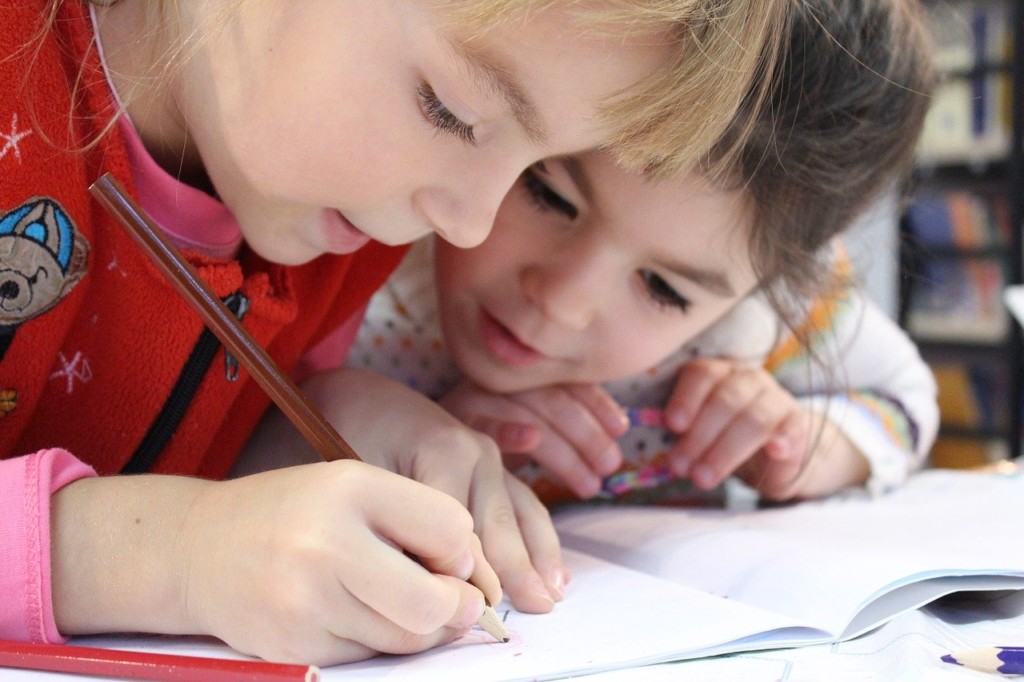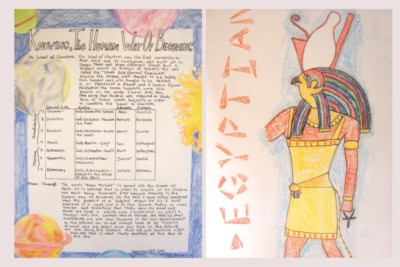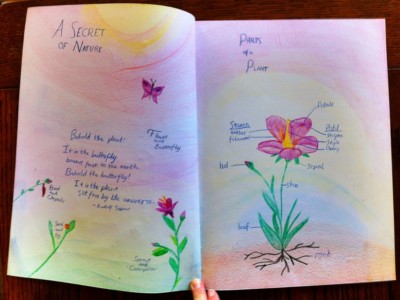We are in the process of helping a Waldorf School work on a distance learning program during this global pandemic of Coronavirus.
This is an interesting project because Waldorf Schools are known for pushing technology to the background. They have a very tactile learning philosophy.
For example, instead of using textbooks, they have students create their own books. They are called Main Lesson books. Here’s a few pictures of them if you haven’t seen one before:
This process ties into highly regarded research that says:
“Keyboarding doesn’t “light up” the literacy sections of the brain in the way handwriting does.”
Typically, a Waldorf school prefers to use methods other than technology to teach their students.
We are in Ohio and all schools are currently closed. This puts a Waldorf school in an interesting predicament. How do we continue educating students while still being true to Waldorf educational philosophies?
There was one clear path with the school I am working with: use technology.
I love this because it makes a clear point: Waldorf schools aren’t “anti technology.” They just believe there are better ways to educate a child. If technology proves to be a valid tool for education then you should use technology.
This is all exciting to me because I got the opportunity to work with a Waldorf School to quickly develop a distance learning strategy using a few key tools. I also got to help with a teacher and staff training program.
I’m writing this post to let you know the tools we used and highlight some observations I’ve made so far.
Zoom
The school made a conscious decision to create a system where they could be in contact with students and parents using video and audio.
I’m seeing some schools sending assignments through tools like Google Classroom. They are using it as a platform to push out assignments and get work returned from students.
There is certainly nothing wrong with Google Classroom. But I don’t think it’s the ideal tool for the current situation Waldorf Schools are in.
First, every student needs a gmail account. This is troublesome for some Waldorf families. They don’t always want their children to have email accounts. This is particularly true for young kids. One of the reasons people sometimes choose a Waldorf school is because there aren’t requirements like having a private laptop and email address.
Second, Google Classroom is a big tool. It can be overwhelming for the end user. This is fine if this is going to be a permanent program. Once people get the hang of it then they become comfortable with it. But I don’t anticipate this being a fundamental change in Waldorf Education. I just don’t see the Waldorf movement permanently moving into an online-centric ideology. Once we can get students back into the classroom the schools will likely let the technology fall to the wayside… particularly for students.
Zoom puts the heavy lifting on the educator’s end. The end user, in this case students and parents, have a fairly easy process of accessing the content.
The strategy for the school at this point with Zoom is two-fold:
- Students will be given pre-recorded lessons that the teachers will make. The school is asking for one video recording each week. The lesson will be automatically recorded to the cloud. And then the link to this recording will be emailed to the families of the students. No new emails need setup. And watching a recording is just like watching any streaming video.
- Parents will be tied into the school through live Zoom meetings. The parent can participate on any device. And if they prefer, they can just call in using any phone. Parents can interact during the session by typing in the chat window. They will also have the opportunity of participating with audio and video. But the meeting starts will all parents muted to begin with.
We did a two hour training session with teachers on this process. I was really excited to see how this would go. And my anticipation did not disappoint. These teachers were great!
I was wondering if there was going to be any pushback. Not one teacher acted disinterested. The only issue I noticed a couple times were that some of the teachers seemed a little overwhelmed because they themselves use technology very minimally.
But many teachers were mind blowingly adept. They adapted SO quickly. They were excited and highly engaged.
It really reiterated to me what Waldorf education is. “Its pedagogy strives to develop pupils’ intellectual, artistic, and practical skills in an integrated and holistic manner. The cultivation of pupils’ imagination and creativity is a central focus.”
I feel like Waldorf is all about adapting holistically.
I think the teachers are going to do fine. Once they do one or two of these Zoom meetings I feel like they are totally going to have the hang of it.
In fact, we had our training on Tuesday and by Thursday the early childhood teachers held a live Zoom meeting for parents. They answered questions using the text chat feature. And the 3 early childhood teachers ran the meeting using the audio and video of their computers. Each teacher was running the meeting from home. It was truly a great presentation.
I just listened to a couple teachers who put out audio recordings of stories for their students. One teacher started the story with a recorder melody and then a song she sang. I really feel like this is going to be appealing to both the parents and the students. I believe in-person is still the best way to meet. But in a situation like what we are in now, these Zoom meetings are a solid alternative when we simply are not able to be together in person.
Scanning and Sending Documents
The next step is to create educational packets for the students.
The idea is that they will create written lessons. These will be scanned in and then sent to a centralized person that will then send the packets and links to video sessions to the students.
With this process one highly technologically savvy person will be sending the content to the parents of each class. The teacher then doesn’t have to worry about that part. The teacher just sends the content to the one centralized person and then that person sends out the information.
This is appealing because if the teacher is having technological problems this centralized person will be there to help them.
I could sense with some teachers that the idea of having to create all the lessons, record the lessons and then digitize the lessons through scanning was A LOT of new and extra steps. I think it won’t be as overwhelming as it may sound. But it definitely feels like a lot. My hope is that we can help facilitate all of this with the teachers especially in the beginning.
The scanning tool we recommended was CamScanner. It works on both iPhone and Android.
The process we discussed was to:
- Create all of your content.
- Lay it all out on a table.
- Use CamScanner to turn all of the week’s material into one pdf.
- Send the pdf to the centralized person.
- That centralized person will then send the material to the families.
I found that one teacher had a couple different documents that they wanted combined into a single pdf. There isn’t an easy way to do this without some sort of tool that makes this possible. I helped her do this with Adobe Acrobat. I believe the school may have the Adobe Creative Cloud. So they should potentially be able to assist teachers if they need help combining files into a single pdf.
Dropbox
We will then be uploading these packets to Dropbox. The families will be able to download the content without having to sign in. All they will have to do is click the link on the email and download the content. They then can either print the material. Or they can just use their device to go through the material.
I felt like this entire process was geared towards making things as easy and as smooth as possible for the families and students.
I also believe the teachers will be offering printed packets that parents can pick up from the school if they prefer.
Conclusion
I’m truly impressed with how fast this school has adapted. This is especially amazing considering as of Tuesday most of these teachers had never used these tools before. And by Friday, today, content is already flowing out of the school into the hands of the students.
I like how the parents are having an opportunity to influence this process as well. For example, the school had an idea that they would only send audio recordings to fifth grade and younger students. But the parents are saying that they would prefer to have full audio and video. I’m interested to see how that evolves.
This also is great because this is a private school. Parents naturally would likely wonder what they are getting for their money when school has been closed. I feel like this is a format that is unique and still represents the Waldorf experience. If my young child was getting a story and song from their teacher along with assignments that still represents the Waldorf pedagogy I think I would feel more than ever that I made the right choice choosing a Waldorf education.
The fact that this school adapted so quickly and developed such a uniquely Waldorf experience to their families says a lot about why someone would want to consider sending their kids to a Waldorf school. The way they shifted and moved around this hurdle speaks directly to the focus of imagination and creativity in Waldorf education. This experience is living proof of why imagination and creativity are such important characteristics in today’s world. Those two traits are exactly what a person needs to succeed in a world that moves as fast as ours.





Well, my kids are in a waldorf school here south of Chile, one in second grade and the other in fifth grade , and it has been a nightmare to try to convince the teachers to use the technology tools available for the rest of the world!. It really feels like they want to keep kids in a buble 🙁 I am so disappointed .